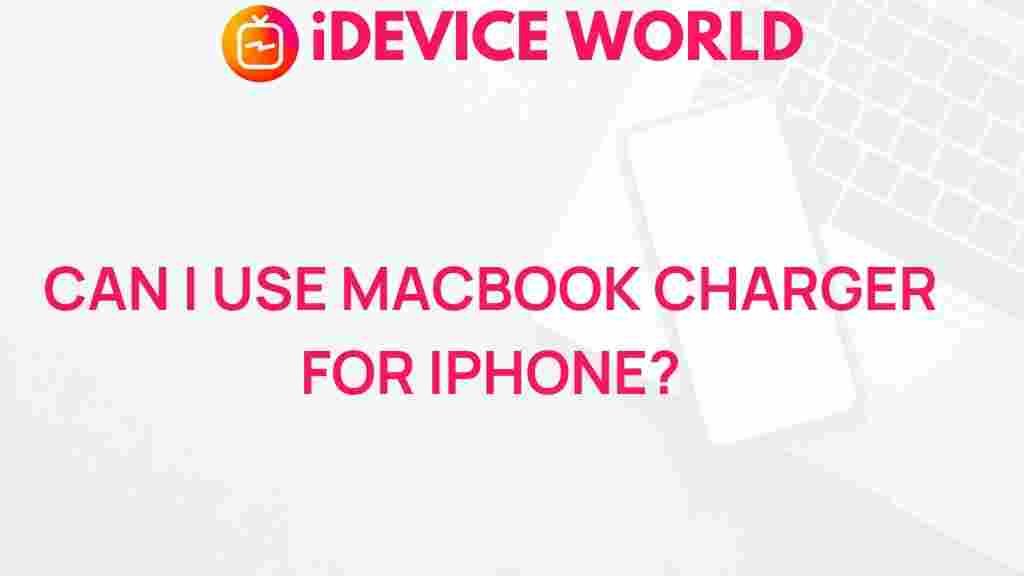Unveiling the Mysteries of Using a MacBook Charger for Your iPhone
As the technology landscape evolves, many users find themselves questioning the compatibility of their devices. One common query is whether a MacBook charger can be used to charge an iPhone. This article aims to clarify this topic, exploring the compatibility, advantages, and potential issues that may arise when using a MacBook charger with your iPhone. We will also provide troubleshooting tips and helpful information to ensure that your charging experience is seamless.
Understanding the Basics of Charging
Before diving into the specifics of using a MacBook charger for your iPhone, it’s essential to understand how charging works for these devices.
Charging Standards
Both MacBook and iPhone utilize USB charging standards, which means that they can generally share power sources. However, there are variations in charging speed and compatibility:
- USB-C: Most modern MacBooks come with USB-C chargers, which are also compatible with many new iPhones.
- Power Delivery (PD): This feature allows for faster charging by increasing the power output.
- Wattage: MacBook chargers typically have a higher wattage compared to standard iPhone chargers, affecting charging speed.
Using a MacBook Charger with Your iPhone
Now that we have a basic understanding of charging standards, let’s look at how to use a MacBook charger with your iPhone effectively.
Step-by-Step Process
Here’s a simple guide to using your MacBook charger to power up your iPhone:
- Check the Charger Type: Ensure that your MacBook charger is equipped with a USB-C port, as this is necessary for compatibility with newer iPhone models.
- Use the Right Cable: You’ll need a USB-C to Lightning cable for the best results. If you have a USB-C to USB-A cable, it will work with older iPhone models.
- Connect the Charger: Plug the USB-C end into your MacBook charger and the Lightning end into your iPhone.
- Monitor the Charging: Once connected, you should see the charging icon on your iPhone’s screen. Keep an eye on the charging speed, as it may differ from your standard charger.
Advantages of Using a MacBook Charger
There are several benefits to using a MacBook charger for your iPhone:
- Faster Charging: Due to the higher wattage of MacBook chargers, you may experience faster charging times, particularly if you’re using a compatible USB-C to Lightning cable.
- Convenience: If you have both devices, using one charger for multiple products can reduce clutter and the need for multiple cables.
- Power Flexibility: The power delivery feature allows for a dynamic adjustment of power levels, ensuring that your devices charge safely.
Common Concerns and Misconceptions
While using a MacBook charger for your iPhone is generally safe, several concerns may arise:
Heat Generation
One common worry is that using a higher wattage charger could generate excessive heat, potentially damaging the iPhone’s battery. However, modern devices are designed to manage heat efficiently. They will regulate the charging current to prevent overheating.
Compatibility Issues
Older iPhone models may not support fast charging, even with a MacBook charger. For these devices, you can still charge them using the MacBook charger, but they will charge at the standard rate.
Troubleshooting Tips
If you encounter issues while charging your iPhone with a MacBook charger, consider the following troubleshooting steps:
- Check the Connections: Ensure that both ends of the charging cable are securely connected.
- Inspect the Cable: Look for any signs of damage or wear on the cable. A damaged cable may not charge your device properly.
- Try a Different Charger: If your iPhone doesn’t charge, test it with a standard iPhone charger to rule out issues with the device itself.
- Update iOS: Ensure your iPhone is running the latest version of iOS, as updates can resolve charging issues.
Conclusion
Using a MacBook charger for your iPhone can be a convenient and efficient way to keep your devices charged. With the right cables and an understanding of charging standards, you can enjoy faster charging times and reduced clutter. Remember to monitor the charging process, especially if you’re using higher wattage chargers, to ensure your devices remain safe.
For more information on charging best practices, you can visit this Apple resource. If you’re interested in optimizing your charging setup further, check out our guide on universal chargers.
This article is in the category Guides & Tutorials and created by iDeciveWorld Team

2 thoughts on “Unveiling the Mysteries of Using a MacBook Charger for Your iPhone”